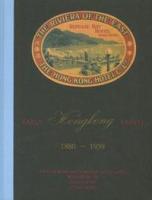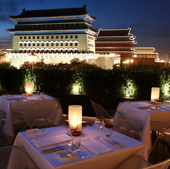Posted: September 23rd, 2011 | No Comments »
Following up on my post about Mark O’Neill’s esteemed ancestor and his missionary activities and work with the Chinese Labour Corps in WW1 – here’s Mark with the famous medal.
 The observant will note the likeness between young Mark here and the good Reverend his grandfather….naturally he can get to play his own grandfather in the inevitable Hollywood film version!
The observant will note the likeness between young Mark here and the good Reverend his grandfather….naturally he can get to play his own grandfather in the inevitable Hollywood film version!
Posted: September 23rd, 2011 | No Comments »
I bumped into a dear old friend, the great journalist Mark O’Neill, in Hong Kong this week when he turned up at a book signing I was doing (he also wrote a kind review of my book in The South China Morning Post). I had known that Mark’s grandfather had been a Presbyterian missionary from Northern Ireland in China before the First World War, had spent much time there and loved the country and the Chinese. I knew Mark was digging around the story with a view to a book (which is apparently now written and should be appearing in Chinese and English from a Hong Kong publisher soon – more details as soon as I hear anything). Several years ago while mooching around a second hand bookshop in London I came across a short volume of Mark’s grandfather’s memoirs which included a wonderful questionnaire at the back that was used to test young missionaries for China – question included ‘Explain the concept of purgatory in Chinese’ and ‘Describe the form and function of the Holy Trinity in Chinese’ – not easy to do that!!
Anyway, catching up with Mark he told me the fantastic tale of how he discovered that his grandfather’s medal (the Order of the Striped Tiger for services to the Chinese Labour Corps in WW1 in France) was up for auction and how he bought it and rescued it from disappearing into a private collection.
The whole story is here from the Irish Times – great reading. I await the book with interest – I’ll try and get Mark to send a photo of the medal too.
 The Reverend Frederick O’Neill and his good lady wife in Faku, Liaoning Province (then Manchuria of course)
The Reverend Frederick O’Neill and his good lady wife in Faku, Liaoning Province (then Manchuria of course)
Posted: September 23rd, 2011 | No Comments »
Evan Osnos, a very nice chap who writes for The New Yorker from China and is the poster boy of foreign correspondents in the PRC, has done a nice piece that shows a little of how renovation, maintenance and, well, not doing much of either, affect Peking’s few surviving hutongs.
Click here

Kuijiachang Hutong – not Osnos’s hutong but a rather nice one that has not succummbed to either bulldozer or endless overpriced, underheated coffee sellers or tat merchants.
Posted: September 22nd, 2011 | No Comments »
For anyone who might be interested
Here’s me talking about Midnight in Peking and China in general on Afternoons with Richard Stubbs on 774 ABC Melbourne radio.
And again on ABC, but this time talking to the very interesting and veteran Aussie broadcaster Philip Adams about Midnight in Peking
A video interview on Midnight, non-fiction writing and research with the Sydney Writers Centre
An OK review from The Australian
A nice online review from Abbey’s Bookstore in Sydney
And, finally, as we’re talking Australia, may I say how nice it was to see that Melbourne has pissoirs. I remember going to Paris is the 1980s and encountering pissoirs and thinking them marvellously French in design, function and execution. That Melbourne has them is unexpected! They are simple though and do prevent all that peeing up alleys and shop doorways!!

Posted: September 22nd, 2011 | No Comments »
As part of The University of Hong Kong’s centennial celebration programme, the University Museum and Art Gallery presents an exhibition on early Hong Kong travel, from 1880 to 1939. In collaboration with an established collector, Benjamin W. Yim, the exhibition, with the participation and support of The Hong Kong Heritage Project, The Hongkong and Shanghai Hotels, Limited and Louis Vuitton, features over 100 exhibits. Vintage menus, cabin trunks, programmes, postcards, photographs, luggage labels, travel guides and brochures, together with other miscellaneous items associated with recreational activities, are on view. To give visitors a glimpse of Hong Kong’s pre-war colonial past, this exhibition, using travel as a theme, attempts to present impressions of Hong Kong as it would appear to European and American visitors arriving by ocean liner. The exhibition presents a number of late nineteenth century features in order to give visitors a realistic experience of what it was like to be in the city a century ago. This volume, Early Hong Kong Travel 1880-1939, is the catalogue of the exhibition.

Posted: September 21st, 2011 | No Comments »
Midnight in Peking takes to the august stage of the RGS in Hong Kong where I’ll be talking a little more about the places and locations of 1937 Peking that feature in the book. Rather worringly we’re in the Social Services building!! I’ve always managed to stay out of the clutches of social services…until now it seems!!

Last days of Old China
Lecture by: Paul French
Location: Auditorium 1/F, Duke of Windsor Social Services Building, 15 Hennessy Road, Wanchai
2011-09-22
RGSÂ HKÂ members HK$100 non members HK$150.
Soft drinks and book signing from 6.30 pm lecture starts 7.30 pm
Chinese historian and author Paul French to speaks on “The Last Days of Old Peking”, focusing on the last days of old Peking in the 1930s, with its pompous Foreign Legations, unstable Chinese government and large criminal underclass.
In 1937, Japanese troops had already moved into Manchuria and were poised to move on Peking. The people of the city nervously waited, enjoying the last days of their indulgent Peking lifestyles. Ever on edge and with tension peaking, the upright residents of the Foreign Legations were brought into collision with the other side of Peking’s foreign community, residing in the city’s infamous ‘Badlands’. Through years of research for his latest book, Midnight in Peking, Paul French discovered that those two worlds of Peking were not as separate or as different as people might have liked to think.
Paul French tells of a city full of intrigue, a city where the authorities were more interested in saving face than solving crimes, a city on the brink of invasion, and in doing so he vividly portrays the last days of old Peking. He also examines the relationships between Chinese and foreigners, the risque nightlife and illegal activities during the 1930s and the early years of the Japanese occupation of Peking.
Peking at that time had a population of some one and a half million, of which only three thousand were foreigners. They were a disparate group, ranging from consuls to destitute White Russians. In between were journalists, a few businessmen, some old China hands, with no shortage of foreign criminals, dope fiends and prostitutes. For the most part, Peking’s foreigners clustered in and around the small enclave known as the Legation Quarter, where the great powers of Europe, America and Japan had their embassies, guarded by imposing gates and armed sentries in a haven of Western architecture, commerce and entertainment.
While calm appeared to prevail on the surface though, both the Chinese and foreign inhabitants of Peking had been living with chaos and uncertainty for a long time. Ever since the downfall of the Qing dynasty in 1911, China had been ruled by the Kuomintang, under the leadership of Chiang Kai-shek, but the government competed for power with the warlords and their private armies, who controlled swathes of territory. Thus, city was at the mercy of marauding warlords, providing a chaotic backdrop for Paul French’s fascinating portrait of the last days of old Peking.
Posted: September 20th, 2011 | No Comments »
The wonderful Sarah Passmore from Hong Kong’s RTHK3 recorded a radio documentary with me earlier this year about Midnight in Peking. We spent a day traipsing all over old Peking looking for remnants of Pamela and the investigation into her murder as well wandering around the Fox Tower, some hutongs and the old Tartar Wall that’s left. We ended it all with a nice brunch and a few drinks at Capital M overlooking the Chienmen Gate. RTHK are running a series of documentaries this month called ‘September Stories’ and this is one of them – click here
And, just to embarass Sarah, I’m going to put her picture up here doing her radio DJ thing. Though I don’t think she’s singing along to my book here!!

And, because it is a great view – here’s the view of Chienmen from the terrace at Capital M –

Posted: September 20th, 2011 | No Comments »
Well done to the discerning and intelligent folk at the Dymocks book shop chain in Hong Kong who selected Midnight in Peking as their book of the month. There’s a whole Q&A with me about the book and the Pamela Werner murder case and some video too.And, if you’re in Hong Kong, they’ve got books piled up for sale too!!

 The observant will note the likeness between young Mark here and the good Reverend his grandfather….naturally he can get to play his own grandfather in the inevitable Hollywood film version!
The observant will note the likeness between young Mark here and the good Reverend his grandfather….naturally he can get to play his own grandfather in the inevitable Hollywood film version!






